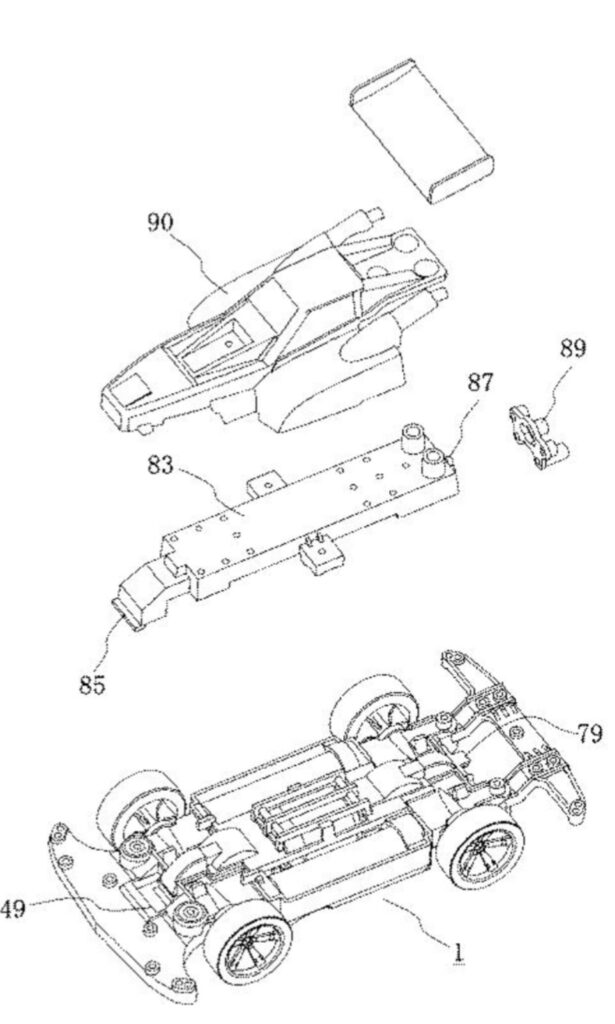
- Introduction: Why Modular Design Matters in Mini 4WD Engineering
- What the Modular Mini 4WD Structure Includes
- How the Modular Mechanism Works
- Benefits: Why Modular Mini 4WD Is Easier to Tune
- Engineering Challenges and Design Considerations
- Patent Attorney’s Thoughts
- Application of the Technology: “Self-Evolving Micro Mobility Ecosystem”
- Final Reflections
Introduction: Why Modular Design Matters in Mini 4WD Engineering
Mini 4WD machines are small but full of engineering potential.
This patent drawing presents a modular assembly structure designed by Tamiya, allowing users to modify, replace, and tune individual components with exceptional ease.
It transforms a simple toy into an accessible learning platform for mechanics and customization.
What the Modular Mini 4WD Structure Includes
The drawing shows a highly organized assembly system featuring:
- A central chassis serving as the structural core
- Detachable front and rear blocks
- A modular motor and gear housing
- A removable aerodynamic body shell
- Standardized connection points enabling flexible configurations
Each component is designed for easy assembly, making upgrades and repairs straightforward.
How the Modular Mechanism Works
The chassis incorporates a series of standardized slots and joints.
Each module—front bumper, rear wing block, gear housing, or shell—locks securely into place.
When the user needs to repair or tune the car, the components can be detached quickly without damaging the structure.
This encourages experimentation while maintaining structural integrity during high-speed runs.
Benefits: Why Modular Mini 4WD Is Easier to Tune
- Faster repairs and part replacement
- Adjustable configurations for different track types
- Educational insight into gear ratios, balance, and aerodynamics
- Lower cost of maintenance due to part independence
- Clear structure suitable for young builders and advanced hobbyists
It simplifies advanced tuning concepts into a hands-on experience.
Engineering Challenges and Design Considerations
Creating a modular racing toy is more difficult than it looks:
- Each connection must be strong yet easy to detach
- The weight balance must remain even
- Vibration from the motor cannot loosen the modules
- Aerodynamics must remain stable despite reconfiguration
These factors reflect thoughtful engineering usually seen in larger machinery.
Patent Attorney’s Thoughts
There is something beautifully democratic about this invention.
By allowing each component to be removed, examined, and replaced, it transforms racing into a conversation between the user and the machine.
It encourages curiosity, making mechanical knowledge accessible through touch and experimentation.
In a world where many devices are sealed and hidden, this design invites the user to participate—reminding us that understanding often begins with taking things apart.
Application of the Technology: “Self-Evolving Micro Mobility Ecosystem”
Purpose
To build a micro mobility platform in which small vehicles evolve through repeated tuning, modular adjustments, and user-driven experimentation.
System Components
- Central chassis module with standard interfaces
- Swappable propulsion units
- Replaceable aerodynamic elements
- Adjustable weight-balancing modules
- Simple performance feedback interface
Operational Flow
- The user builds the initial vehicle configuration using preferred modules.
- The vehicle is tested on a track to observe performance, balance, and turning behavior.
- The user analyzes which modules influence acceleration, stability, or cornering.
- Modules are rearranged or replaced for improvement.
- Through repeated trials, the vehicle “evolves” into a custom high-performance setup.
Final Reflections
Tamiya’s modular Mini 4WD design turns engineering into something personal and playful.
Its modularity encourages learning, creativity, and a deeper connection between builder and machine.
Disclaimer: This content is an AI-generated reinterpretation based on a patent drawing.
It is provided for educational and cultural purposes only, and not as legal advice.



